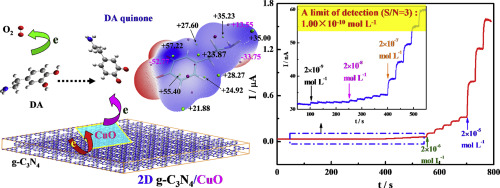Our official English website, www.x-mol.net, welcomes your
feedback! (Note: you will need to create a separate account there.)
An ultra-sensitive electrochemical sensor based on 2D g-C 3 N 4 /CuO nanocomposites for dopamine detection
Carbon ( IF 10.5 ) Pub Date : 2018-04-01 , DOI: 10.1016/j.carbon.2018.01.008 Jing Zou , Shengli Wu , Yi Liu , Yanjuan Sun , Yuan Cao , Jyh-Ping Hsu , Andrew Thye Shen Wee , Jizhou Jiang
Carbon ( IF 10.5 ) Pub Date : 2018-04-01 , DOI: 10.1016/j.carbon.2018.01.008 Jing Zou , Shengli Wu , Yi Liu , Yanjuan Sun , Yuan Cao , Jyh-Ping Hsu , Andrew Thye Shen Wee , Jizhou Jiang

|
Abstract A facile sensor based on two-dimensional (2D) g-C3N4/CuO nanocomposites was proposed for electrochemical detection of dopamine (DA). The 2D g-C3N4/CuO nanocomposites were fabricated by a pyrolysis technique using melamine and cupric acetate monohydrate as precursors. The 2D g-C3N4/CuO nanocomposites prepared have a larger conductivity and a narrower band-gap than that of pure g-C3N4, resulting in higher electrochemical activity for sensing of DA. The response of this sensor is linear over the range of 2.00 × 10−9 to 7.11 × 10−5 mol L−1 with a detection limit of 1.00 × 10−10 mol L−1. The ultra-high sensitivity can be attributed to an electron transfer process on the surface of the sensor, where the 2D g-C3N4/CuO is a powerful electron donor and the oxidized DA quinone functions as an efficient electron acceptor, as confirmed by density functional theory (DFT) calculations. The sensor showed a high selectivity to DA over common interfering biological small molecules (including glucose, uric acid and ascorbic acid), as the DA quinone possesses the most positive electrostatic potential and the smallest electron-injection-barrier between the 2D g-C3N4/CuO and DA quinone, which was also supported by DFT calculations. The proposed novel sensor provides a facile yet ultra-sensitive electrochemical sensing method for detecting trace DA in real biological samples.
中文翻译:

基于二维 gC 3 N 4 /CuO 纳米复合材料的超灵敏电化学传感器用于多巴胺检测
摘要 提出了一种基于二维 (2D) g-C3N4/CuO 纳米复合材料的简便传感器,用于多巴胺 (DA) 的电化学检测。二维 g-C3N4/CuO 纳米复合材料是通过使用三聚氰胺和一水醋酸铜作为前体的热解技术制备的。所制备的二维 g-C3N4/CuO 纳米复合材料比纯 g-C3N4 具有更大的电导率和更窄的带隙,从而提高了传感 DA 的电化学活性。该传感器的响应在 2.00 × 10-9 至 7.11 × 10-5 mol L-1 的范围内呈线性,检测限为 1.00 × 10-10 mol L-1。超高灵敏度可归因于传感器表面的电子转移过程,其中 2D g-C3N4/CuO 是强大的电子供体,氧化的 DA 醌作为有效的电子受体,密度泛函理论 (DFT) 计算证实了这一点。该传感器对常见的干扰性生物小分子(包括葡萄糖、尿酸和抗坏血酸)表现出对 DA 的高选择性,因为 DA 醌在 2D g-C3N4/ DFT 计算也支持 CuO 和 DA 醌。所提出的新型传感器为检测真实生物样品中的痕量 DA 提供了一种简便而超灵敏的电化学传感方法。由于 DA 醌在 2D g-C3N4/CuO 和 DA 醌之间具有最大的正静电势和最小的电子注入势垒,这也得到了 DFT 计算的支持。所提出的新型传感器为检测真实生物样品中的痕量 DA 提供了一种简便而超灵敏的电化学传感方法。由于 DA 醌在 2D g-C3N4/CuO 和 DA 醌之间具有最大的正静电势和最小的电子注入势垒,这也得到了 DFT 计算的支持。所提出的新型传感器为检测真实生物样品中的痕量 DA 提供了一种简便而超灵敏的电化学传感方法。
更新日期:2018-04-01
中文翻译:

基于二维 gC 3 N 4 /CuO 纳米复合材料的超灵敏电化学传感器用于多巴胺检测
摘要 提出了一种基于二维 (2D) g-C3N4/CuO 纳米复合材料的简便传感器,用于多巴胺 (DA) 的电化学检测。二维 g-C3N4/CuO 纳米复合材料是通过使用三聚氰胺和一水醋酸铜作为前体的热解技术制备的。所制备的二维 g-C3N4/CuO 纳米复合材料比纯 g-C3N4 具有更大的电导率和更窄的带隙,从而提高了传感 DA 的电化学活性。该传感器的响应在 2.00 × 10-9 至 7.11 × 10-5 mol L-1 的范围内呈线性,检测限为 1.00 × 10-10 mol L-1。超高灵敏度可归因于传感器表面的电子转移过程,其中 2D g-C3N4/CuO 是强大的电子供体,氧化的 DA 醌作为有效的电子受体,密度泛函理论 (DFT) 计算证实了这一点。该传感器对常见的干扰性生物小分子(包括葡萄糖、尿酸和抗坏血酸)表现出对 DA 的高选择性,因为 DA 醌在 2D g-C3N4/ DFT 计算也支持 CuO 和 DA 醌。所提出的新型传感器为检测真实生物样品中的痕量 DA 提供了一种简便而超灵敏的电化学传感方法。由于 DA 醌在 2D g-C3N4/CuO 和 DA 醌之间具有最大的正静电势和最小的电子注入势垒,这也得到了 DFT 计算的支持。所提出的新型传感器为检测真实生物样品中的痕量 DA 提供了一种简便而超灵敏的电化学传感方法。由于 DA 醌在 2D g-C3N4/CuO 和 DA 醌之间具有最大的正静电势和最小的电子注入势垒,这也得到了 DFT 计算的支持。所提出的新型传感器为检测真实生物样品中的痕量 DA 提供了一种简便而超灵敏的电化学传感方法。











































 京公网安备 11010802027423号
京公网安备 11010802027423号